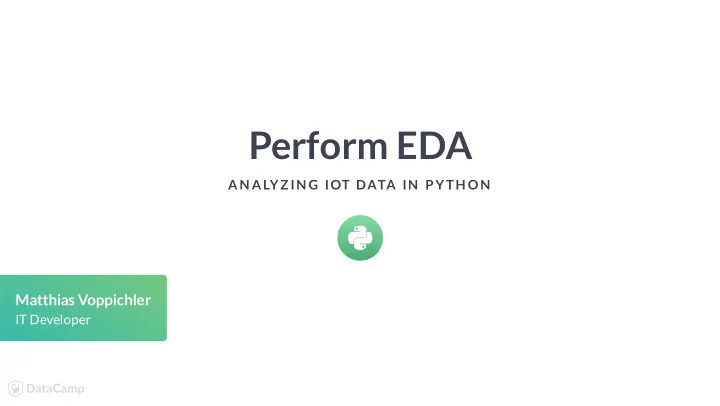

Perform EDA AN ALYZ IN G IOT DATA IN P YTH ON Matthias Voppichler IT Developer
Plot dataframe df.plot(title="Environment") ANALYZING IOT DATA IN PYTHON
Line plot df[["temperature", "humidity"]].plot(title="Environment") plt.xlabel("Time") ANALYZING IOT DATA IN PYTHON
Secondary y plt.ylabel('Temperature') df[["temperature", "pressure"]].plot(title="Environment", secondary_y="pressure") plt.ylabel('Pressure') ANALYZING IOT DATA IN PYTHON
Histogram basics ANALYZING IOT DATA IN PYTHON
Histogram df.hist(bins=20) ANALYZING IOT DATA IN PYTHON
Let's practice! AN ALYZ IN G IOT DATA IN P YTH ON
Clean Data AN ALYZ IN G IOT DATA IN P YTH ON Matthias Voppichler IT Developer
Missing data Reasons for missing data from IoT devices Unstable network connection No power Other External factors Times to deal with data quality During data collection During analysis ANALYZING IOT DATA IN PYTHON
Dealing with missing data Methods to deal with missing data �ll mean median forward-�ll backward-�ll drop stop analysis ANALYZING IOT DATA IN PYTHON
Detecting missing values df.info() <class 'pandas.core.frame.DataFrame'> DatetimeIndex: 12 entries, 2018-10-15 08:00:00 to 2018-10-15 08:55:00 Data columns (total 3 columns): temperature 8 non-null float64 humidity 8 non-null float64 precipitation 12 non-null float64 dtypes: float64(3) memory usage: 384.0 bytes ANALYZING IOT DATA IN PYTHON
Drop missing values print(df.head()) temperature humidity precipitation timestamp 2018-10-15 08:00:00 16.7 64.2 0.0 2018-10-15 08:05:00 16.6 NaN 0.0 2018-10-15 08:10:00 16.5 65.3 0.0 2018-10-15 08:15:00 NaN 65.0 0.0 2018-10-15 08:20:00 16.8 64.3 0.0 df.dropna() temperature humidity precipitation timestamp 2018-10-15 08:00:00 16.7 64.2 0.0 2018-10-15 08:10:00 16.5 65.3 0.0 2018-10-15 08:20:00 16.8 64.3 0.0 ANALYZING IOT DATA IN PYTHON
Fill missing values df temperature humidity precipitation timestamp 2018-10-15 08:00:00 16.7 64.2 0.0 2018-10-15 08:05:00 16.6 NaN 0.0 2018-10-15 08:10:00 17.0 65.3 0.0 2018-10-15 08:15:00 NaN 65.0 0.0 2018-10-15 08:20:00 16.8 64.3 0.0 df.fillna(method="ffill") temperature humidity precipitation timestamp 2018-10-15 08:00:00 16.7 64.2 0.0 2018-10-15 08:05:00 16.6 64.2 0.0 2018-10-15 08:10:00 17.0 65.3 0.0 ANALYZING IOT DATA IN PYTHON
Interrupted Measurement df_res = df.resample("10min").last() print(df.head()) print(df_res.head()) timestamp temperature humidity timestamp temperature humidity 2018-10-15 00:00:00 13.5 84.7 2018-10-15 00:00:00 13.5 84.7 2018-10-15 00:10:00 13.3 85.6 2018-10-15 00:10:00 13.3 85.6 2018-10-15 00:20:00 12.9 88.8 2018-10-15 00:20:00 12.9 88.8 2018-10-15 00:30:00 12.8 89.2 2018-10-15 00:30:00 12.8 89.2 2018-10-15 00:40:00 13.0 87.7 2018-10-15 00:40:00 13.0 87.7 print(df.isna().sum()) print(df_res.isna().sum()) temperature 0 temperature 34 humidity 0 humidity 34 dtype: int64 dtype: int64 ANALYZING IOT DATA IN PYTHON
Interrupted Measurement df_res.plot(title="Environment") ANALYZING IOT DATA IN PYTHON
Let's practice! AN ALYZ IN G IOT DATA IN P YTH ON
Gather minimalistic incremental data AN ALYZ IN G IOT DATA IN P YTH ON Matthias Voppichler IT Developer
What is caching? storing data After data stream collection Observation by observation Creates high load on Disks Use caching ANALYZING IOT DATA IN PYTHON
Caching cache = [] def on_message(client, userdata, message): data = json.loads(message.payload) cache.append(data) if len(cache) > MAX_CACHE: with Path("data.txt").open("a") as f: f.writelines(cache) cache.clear() # Connect function to mqtt datastream subscribe.callback(on_message, topics="datacamp/energy", hostname=MQTT_HOST) ANALYZING IOT DATA IN PYTHON
Simplistic datastreams C331,6020 M640,104 C331,6129 M640,180 C331,6205 M640,256 ANALYZING IOT DATA IN PYTHON
Observation Timestamp "timestamp in payload" message.timestamp datetime.now() ANALYZING IOT DATA IN PYTHON
Observation Timestamp def on_message(client, userdata, message): publishtime = message.timestamp consume_time = datetime.utcnow() ANALYZING IOT DATA IN PYTHON
pd.to_datetime() print(df.head()) timestamp device val 0 1540535443083 C331 347069.305500 1 1540535460858 C331 347069.381205 import pandas as pd df["timestamp"] = pd.to_datetime(df["timestamp"], unit="ms") timestamp device val 0 2018-10-26 06:30:43.083 C331 347069.305500 1 2018-10-26 06:31:00.858 C331 347069.381205 ANALYZING IOT DATA IN PYTHON
Let's practice! AN ALYZ IN G IOT DATA IN P YTH ON
Prepare and visualize incremental data AN ALYZ IN G IOT DATA IN P YTH ON Matthias Voppichler IT Developer
Data preparation Pivot data Resample Apply diff() Apply pct_change() ANALYZING IOT DATA IN PYTHON
Data structure print(data.head()) timestamp device value 0 2018-10-26 06:30:42.817 C331 6020.0 1 2018-10-26 06:30:43.083 M640 104.0 2 2018-10-26 06:31:00.858 M640 126.0 3 2018-10-26 06:31:10.254 C331 6068.0 4 2018-10-26 06:31:10.474 M640 136.0 ANALYZING IOT DATA IN PYTHON
Pivot table ANALYZING IOT DATA IN PYTHON
Apply pivot table timestamp device value 0 2018-10-26 06:30:42.817 C331 6020.0 1 2018-10-26 06:30:43.083 M640 104.0 2 2018-10-26 06:31:00.858 M640 126.0 3 2018-10-26 06:31:10.254 C331 6068.0 4 2018-10-26 06:31:10.474 M640 136.0 data = pd.pivot_table(data, columns="device", values="value", index="timestamp") print(data.head() device C331 M640 timestamp 2018-10-26 06:30:42.817 6020.0 NaN 2018-10-26 06:30:43.083 NaN 104.0 2018-10-26 06:31:00.858 NaN 126.0 2018-10-26 06:31:10.254 6068.0 NaN 2018-10-26 06:31:10.474 NaN 136.0 ANALYZING IOT DATA IN PYTHON
Resample # Resample dataframe to 1min df = data.resample("1min").max().dropna() print(df.head()) device C331 M640 timestamp 2018-10-26 06:30:00 6020.0 104.0 2018-10-26 06:31:00 6129.0 180.0 2018-10-26 06:32:00 6205.0 256.0 2018-10-26 06:33:00 6336.0 332.0 2018-10-26 06:34:00 6431.0 402.0 ANALYZING IOT DATA IN PYTHON
Visualize data data.plot() plt.show() ANALYZING IOT DATA IN PYTHON
pd.diff() # Difference df_diff = data.diff(1) df_diff.plot() plt.show() ANALYZING IOT DATA IN PYTHON
Data analysis - difference # Difference # Resampled difference df_diff = data.diff() df = data.resample('30min').max() df_diff.plot() df_diff = df.diff() plt.show() df_diff.plot() plt.show() ANALYZING IOT DATA IN PYTHON
Change percentage df_pct = df_diff.pct_change() df_pct.plot() ANALYZING IOT DATA IN PYTHON
Let's Practice AN ALYZ IN G IOT DATA IN P YTH ON
Recommend
More recommend